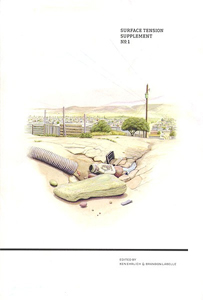Identifying an intensified concern for place-based production in art and architecture, Surface Tension – Supplements addresses questions of site-specific art, public and architectural design, and location-based practice.
With
Supplement No. 1 issues of spatial practice are explored in critical essays by Jennifer Gabrys on the geographic implications of Fresh Kills Landfill, Scott Berzofsky, Nicholas Petr, Nicholas Wisniewski & Michael Rakowitz on artistic interventions in Baltimore, and by Claudine Isé, curator of “Vanishing Point”, an exhibition at the Wexner Center for the Arts, which questions the aesthetics of urban non-spaces through recent photography and film. In addition field reports by Robin Wilson on public art projects in Bristol, Goto Newton on the cultures of interventionist practice in Curitiba Brazil, and Ken Ehrlich on the infrastructure of signage in Los Angeles as seen through the photographic works of Brandon Lattu complement the articles. In addition, documentation of public projects in Tijuana and Ohio by the artist groups Simparch and e-Xplo will be presented, along with projects designed specifically for the book by
Sophie Warren and Jonathan Mosely, a Bristol-based team working with questions of utopian architecture, and
Brandon LaBelle with a textual-photographic meditation on experimental architecture. Additional writings by Kathy Battista and Aoife O'Brien provide critical and creative perspectives on recent events, books, and exhibitions working with questions of architecture, performance, and media.
Following the publication of
Surface Tension: Problematics of Site in 2003,
Surface Tension appears regularly as a series of published
Supplements (launched 2006) that continues the artistic and philosophical program initiated in the original anthology. The series addresses questions of site-specific art, public and architectural space, and location-based practices, supporting investigations onto public practices through writing, documentation, and field work, while questioning what role such practices can offer in defining contemporary culture.

